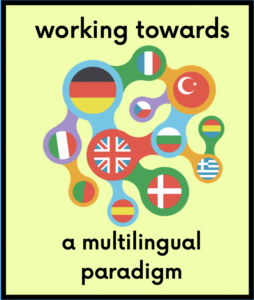
1) As Lucy, Joy, and Evelyn remind us, adopting a multilingual paradigm “involves a shift in perspective and a willingness to engage in learning ourselves.” So begin by trying out one or two low-stakes multilingual activities or assignments. As we gain more experience, add or modify more activities or assignments. Don’t overwhelm ourselves by overhauling the syllabus overnight.
2) Be sensitive to the fact that a large proportion of our students are English-speaking, and always let them know that it is perfectly okay if you only speak English or a variety of English.
3) Be respectful of the fact that not all heritage students like the multilingual teaching approach. Many students come from ESL, TBE or other similar programs in the U.S. or their home country where heritage languages play no or little role in their English education. “I’m here to learn English” is at the top of their mind.
4) This brings us to another point: multilingualism in college composition is a complicated and controversial issue. Is multilingualism a means to an end, i.e. good writing by academic or professional standards? Or is multilingualism a goal in and of itself? Or is this means-versus-end dilemma a false dichotomy? Some of us may be sympathetic with the language justice movement and are critical of standard American English as the Master’s Language. Yet, we must acknowledge that students need it in their education, career and professional advancement. Many of us are concerned that students will be judged if their writing does not conform to academic or professional standards.
Additional Resources
1) Dr. Lucy McNair collected and developed materials related to multilingualism. We are grateful to her for sharing her wonderful collection. I particularly recommend Dr. McNair’s Language Awareness Writing Assignment:
- A slide that sums up the shift from monolingualism to a multilingual model (shared during the event)
- A brief article on terminology by Mi Sun Park
- A summary of principles (via the CTL seminar Language Across the Curriculum)
- A teaching resource sheet with links
- A sample assignment
- Results from a departmental multilingualism event survey
2) Dr. J. Elizabeth Clark and Dr. Tara Coleman of our department also collected equally informative materials on multilingualism and translanguaging. I thank them for their collection.
3) Dr. Tomonori Nagano of LaGuardia’s English and Language Acquisition Department published an interesting introduction to bilingualism in Queens. His article provides a list of “Resources to learn more about linguistic diversity in Queens and NYC.”
“How bilingual is Queens?” Ad Astra: Undergraduate Research Newsletter of LaGuardia Community College, vol. 2, 2021, http://www.adastraletter.com/2021/2/bilingual-queensSee also Dr. Nagao’s article cited above: “How Many Languages Are Spoken at LaGuardia? There Is No Simple Answer.”




Leave a Reply